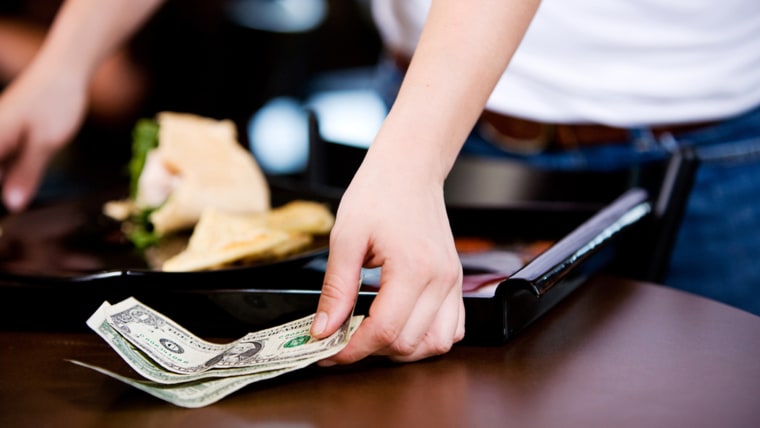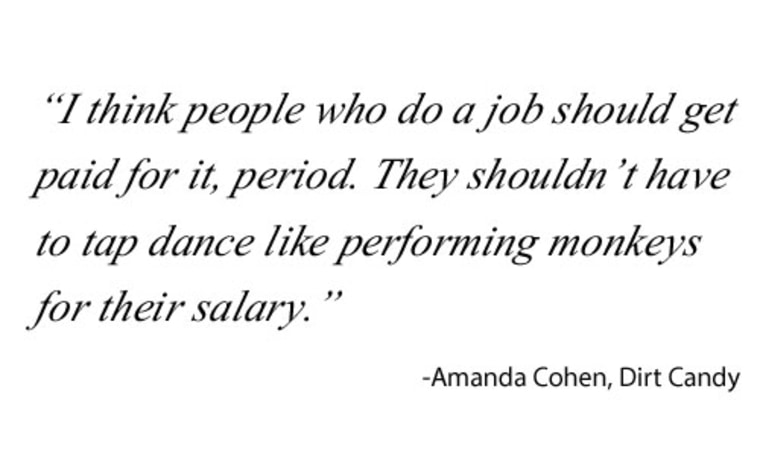Every so often, the debate over restaurant tipping rages — but this time, rising minimum wages and moves by high-profile chefs are really putting the future of the tip line in jeopardy.
The debate goes like this: Anti-tippers say that people’s wages shouldn’t depend on people’s moods or generosity, the weather, or their performance as subject to customer perception (plus, they say, it’s not fair to the back-of-house workers, such as dishwashers, who often make less than servers). Pro-tippers say that restaurant profit margins are just too slim, and that abolishing tipping would drive up menu prices.

The National Restaurant Association is firmly in the pro-tipping camp: After the 2007 minimum wage increase, restaurants increased prices an average of 58 percent, according to its research. Pre-tax profit margins for restaurants range from 3 to 6 percent, it adds.
Servers’ median hourly earnings range from $16 to $22 nationally, which includes the median base wage of about $4 to $5 an hour, according the association. (The current federal minimum for tipped employees is $2.13 per hour, though it’s higher in some states.)

One city that recently took cost-of-living matters into its own hands is Seattle, where an $11 minimum wage went into effect in April; it will gradually increase to $15, over a seven-year phase for small businesses and over a three-year phase for businesses with more than 500 employees.
Local media there have reported that some customers are already skimping on tips, seeing them as no longer needed, even though the full wage hike is years off.
“It’s way too early to say an absolute theme has emerged, but people are trying to figure out how this new model will work,” says Anthony Anton, president and CEO at the Washington Restaurant Association. “Before the change, the average margins here were +4 percent. If nothing else changes, the margins will be -6 percent [once the wage hike takes full effect], so some things will have to change. How will we rework the model to make things fair for everyone?”
Aside from pooling and redistributing service charges, some restaurants may consider streamlining things with centralized kitchens or pre-prepared foods, he adds. “There will essentially be no more entry-level labor in Seattle anymore,” he says. “How do you replace that?”
Elsewhere, tip-ditching chefs are finding a positive value in their new model: boosted morale of the staff.
At Dirt Candy, an award-winning vegetable restaurant in New York City, chef and owner Amanda Cohen eliminated the tip line on checks earlier this year, replacing it with a 20 percent administration fee.
She says that her decision is based on common human decency: “I think people who do a job should get paid for it, period. They shouldn’t have to tap dance like performing monkeys for their salary.”
She’s also passionate about more evenly distributing cash to make sure that her entire staff — not just the ones who in the public eye — get a paycheck on which they can live, regardless of how busy the restaurant is on a particular night. “Yes, my servers get paid maybe $50 per night less than they’d make elsewhere, but they have a set wage that they can rely on, whether it’s snowing out or sunny weather, and everyone in my restaurant gets a healthy hourly wage.”
Cohen isn’t the only one who sees it that way. Jodi Richard, chef at New York City’s Atera, notes that making Atera a “tip included” restaurant allows her to extend healthcare benefits to all of her employees. It’s worth noting that both of these restaurants are high-end establishments — does that mean that smaller mom-and-pop joints can’t adopt this structure?
Not by the looks of Packhouse, a casual sandwich shop in Newport, Kentucky. Owner Bob Conway started his restaurant as a no-tipping venture as a competitive move, making it the only casual game in town that had an all-inclusive service policy for diners (each check contains a 20 percent gratuity). The effects, Conway says, are far-reaching.
Conway reports “low turnover, high morale and great team play within the staff.” Staffers are going above and beyond, without being asked. “We found if you take care of your employees, they take care of you,” he says.
Minimum wage hikes won’t affect him, as he already pays above it, he says. All-inclusive pricing also benefits casual-restaurant employees, because the checks are smaller than at higher-end places, he points out. Plus, he says, diners benefit by knowing the exact cost of their bill, with no games.
So will we see the tip line disappear at Applebee’s? Eventually, predicts at least one chef:
“We do think this is the future,” says Cristian Mora, owner of tip-included restaurant Girard on Girard in Philadelphia. “We and others are the few early adopters and the tipping point will come when one of the bigger restaurateurs or chains in the country adopts this practice.”
Do you hate tipping or should restaurants just stick with it?